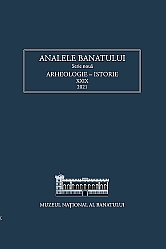Noi descoperiri în vechi colecții: un vas antropomorf de tip „dublu Janus” descoperit la Trușești
New discoveries in old collections: A “Double Janus” anthropomorphic vessel discovered in Trușești
Author(s): Senica TurcanuSubject(s): Archaeology, Prehistory
Published by: Editura Mega Print SRL
Keywords: anthropomorphic vessels; Double Janus; Cucuteni-Trypillia culture; Gumelnita-Karanovo VI culture;
Summary/Abstract: The main purpose of our study is to (re) introduce into the scholarly circuit – with all the necessary details – an anthropomorphic vessel of a particular type discovered in Trușești-Țuguieta (Botoșani County) more than six decades ago (pl. 1-2). Its correct typological description and classification brings a new perspective on the symbolism embedded in these vessels, as an important category of sacred objects, which have a hermeneutic potential still not completely unveiled. Published in the site monograph as a vessel with a “lobed body” , the container is an anthropomorphic vessel regarded up to the present as one of a kind within the archaeological discoveries in the Cucuteni-Trypillia area. Viewed from any of its four sides, the vessel depicts the front of a female anthropomorphic figure. Specifically, it depicts the abdominal area and hips of four female figures positioned back-to-back. The female shapes are rendered in a typical representation for the Cucuteni anthropomorphic vessels, with emphasis on the abdomen and groin area, on the wide-shaped hips merges with the rest of the vessel. Referring to the typological classification made previously by us for some of the anthropomorphic vessels with a quasi-symmetrical profile, regarded as double-sided vessels of “janiform type” (pl. 3/3-4; 4), one can assert that this four-sided container is of “double Janus” type, being characterized by a feature that has been defined as an “image multiplication”. The presentation of the “double Janus”-type vessel of Trușești also gives us an opportunity to review the known archaeological data regarding the finding contexts of anthropomorphic vessels, of Cucuteni or from the contemporary and neighboring cultural areas. Their analysis allowed us to notice certain patterns of usage and abandonment of these containers, as well as the high frequency of certain associations with other types of rare artifacts, many indicated in archaeological studies as “cult pieces”. The synthesized data support the role of such anthropomorphic vessels as paraphernalia, artifacts that were used in ritual scenographies with a precisely defined role (which today can only be guessed), which is also polysemantic, being a special channel of nonverbal communication.
Journal: Analele Banatului S.N. Arheologie-Istorie
- Issue Year: XXIX/2021
- Issue No: 1
- Page Range: 117-136
- Page Count: 20
- Language: Romanian

